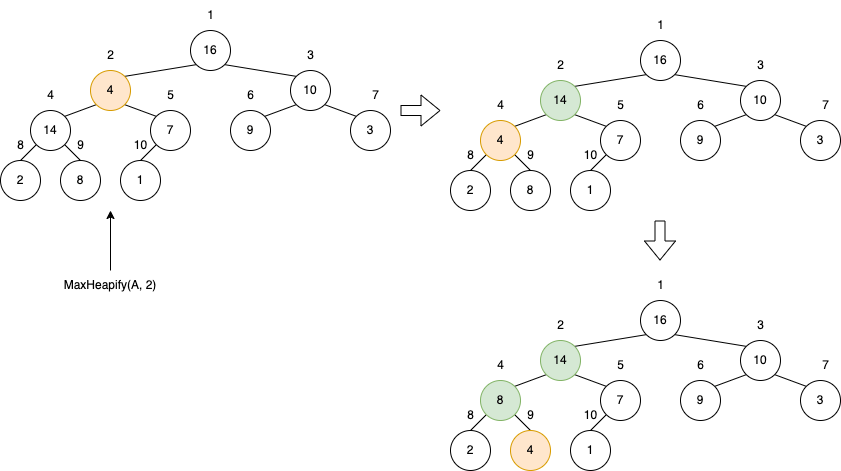Priority queue 是一個很好用的 data structure。它可以在常數時間內提供最大或最小值。在了解它之前,我們要先了解另一個 data structure 叫 heap。因為 priority queue 常常會用 heap 來實作。
Table of Contents
Heap
Heap data structure 是一個 array,我們可以將它視為一個 complete binary tree。我們用 A[1:n] 表示 heap 的 array,所以 A 是一個大小為 n 的 array。A 的 index 從 1 開始。A.heapSize 表示有 heapSize 個元素儲存在 A 裡面,所以 。下圖顯示一個 max-heap 以 tree 的方式呈現,以及它的元素如何儲存在 array 裡。

因為 heap 實際上是一個 array,但我們卻會將它當成一個 complete binary tree。所以,對一個 node i 也就是 index i,我們常常需要取得它的 parent、left child、和 right child。
Parent(i) {
return floor(i / 2)
}
Left(i) {
return 2 * i
}
Right(i) {
return 2 * i + 1
}Heap Property
Heap 有兩種,一種是 max-heap,另一種是 min-heap。Max-heap 的 property 是,對於每一個 node i,它的值比它的 subtree 裡所有 node 的值大。反之,min-heap 的 property 是,對於每一個 node i,它的值比它的 subtree 裡的所有 node 的值小。所以,max-heap 的 root 是最大值;而 min-heap 的 root 是最小值。
維護 Heap Property
每個 heap 都要滿足它的 property。當一個 heap 違反它的 property 時,我們需要一個 procedure 來使 heap 滿足它的 property。我們可以用以下的 MaxHeapify 來使一個 subtree 滿足 max-heap property。
MaxHeapify 的輸入是 heap 的 array 和 index i。如果 node i 違反 max-heap property 的話,它可以使得 node i 和它 subtree 滿足 max-heap property。MaxHeapify 比較 node i 與它的 left 和 right children,並將 node i 與最大的 child 交換,然後再 recursively 對被交換的 child 做相同的動作。MaxHeapify 的時間複雜度為 ,其中 h 為樹的高度。
Algorithm MaxHeapify(A, i) {
left := Left(i)
right := Right(i)
if left <= A.heapSize && A[left] > A[i] {
largest := left
} else {
largest := i
}
if right <= A.heapSize && A[right] > A[largest] {
largest := right
}
if largest != i {
swap(A[i], A[largest])
MaxHeapify(A, largest)
}
}以下的範例是對 index 2 的 node 做 MaxHeapify(A, 2)。

建立 Heap
下面的演算法 BuildMaxHeap 是將一個 array A[1:n] 轉換成一個 max-heap。它的時間複雜度是 。
Algorithm BuildMaxHeap(A, n) {
A.heapSize := n
for i := floor(n / 2) to 1 {
MaxHeapify(A, i)
}
}
Priority Queue
Priority queue 是一個 data structure,且維護一群元素集合 S。Priority queue 有兩種,一種是 max-priority queue,另一種是 min-priority queue。一個 max-priority queue 提供以下操作:
- Max(S):回傳 S 中的最大值。
- ExtractMax(S):移除並回傳 S 中的最大值。
- Insert(S, x):將 x 加入到 S 中。
因為 max-priority queue 的 Max(S) 和 ExtractMax(S),所以我們可以用 max-heap 來實作 max-priority queue。以下是 max-priority queue 的演算法,其中 A 表示 max-heap 的 array。另外,它們的時間複雜度如下:
- Max(A):
- ExtractMax(A):
- Insert(A, x):
Algorithm Max(A) {
if A.heapSize < 1 {
error "heap underflow"
}
return A[1]
}
Algorithm ExtractMax(A) {
max := Maximum(A)
A[1] := A[A.heapSize]
A.heapSize := A.heapSize - 1
MaxHeapify(A, 1)
return max
}
Algorithm Insert(A, x) {
if A.heapSize == A.size {
error "A has no room for x"
}
A.heapSize := A.heapSize + 1
A[A.heapSize] = x
i := A.heapSize
while i > 1 && a[Parent(i)] < x {
swap(A[i], A[Parent(i)])
i := Parent(i)
}
}參考
- Ellis Horowitz, Sartaj Sahni, Sanguthevar Rajasekaran, Computer Algorithm.
- Thomas H. Cormen, Charles E. Leiserson, Ronald L. Rivest, Clifford Stein, Introduction to Algorithms, 4th Ed.










